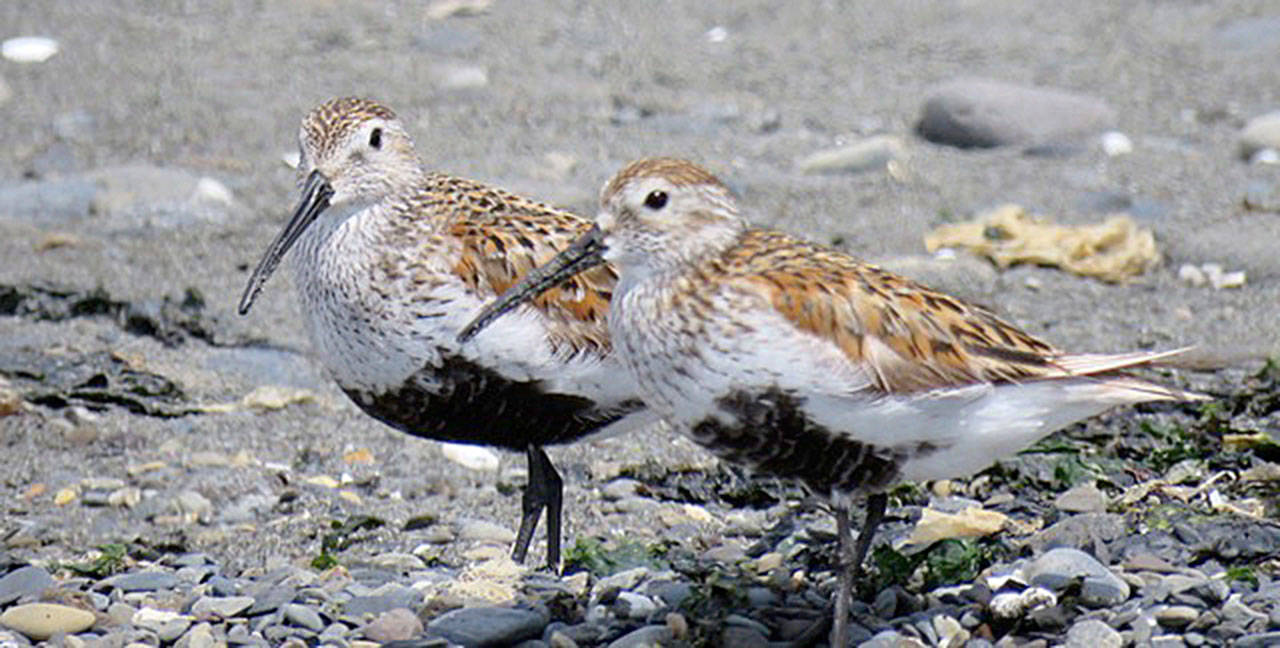Shorebirds have long migrations, and must stop and refuel, building up fat to fuel their onward journeys. Their long beaks, legs and toes are perfect for wading around in search of food in the mud and shallow water.
Tens of thousands of shorebirds from across the Western Hemisphere use the mudflats at the mouth of the Dungeness River as a critical resting and feeding stop during migration.
Dungeness Bay is so noteworthy that it has received the designation “Important Bird Area” — identified as being significant habitat for the conservation of bird populations.
Why do the shorebirds come here to the Dungeness River mouth mudflats? As it descends from the Olympic Mountains, the Dungeness River accumulates rich nutrients from the soil and forest. Flowing into Dungeness Bay, it creates an estuary, where fresh water from land meets and mixes with salt water from the ocean.
Estuaries transport and trap nutrients and sediment, providing a rich and critical habitat for birds, fish, insects and other wildlife. The National Oceanic and Atmospheric Administration (NOAA) calls estuaries “important natural places to the economy and the environment.”
Dungeness Bay is one of the premier estuaries in the Pacific Northwest, and Dungeness Spit and adjacent inter-tidal areas also lie within the Dungeness National Wildlife Refuge. Its sandflats and mudflats include some of the largest eelgrass beds in the Northwest.
More than 40 species of shorebirds have been recorded in and around Dungeness Bay. Some will choose to stay here for the winter, like Black-bellied Plover, Dunlin and Sanderling. They nest in high Arctic tundra around the entire northern Hemisphere, then migrate to spend the winter on coastlines throughout the world.
Others are just stopping to refuel, like Least Sandpipers who nest in subarctic tundra and boreal forest across Alaska and Canada. They weigh less than an ounce, yet likely have astounding 2,000-mile non-stop transoceanic migrations. Western Sandpipers nest in coastal tundra in Western Alaska and Siberia, then migrate along the Pacific Coast all the way to Peru. Semipalmated Plovers nest in the subarctic and winter in widespread coastal areas, including Central America.
The Short-billed Dowitcher subspecies seen in Dungeness Bay nests in Alaska and winters on the Pacific Coast all the way to South America.
The long-distance champions are Baird’s Sandpiper and Red Knot. After departing their high-arctic breeding grounds, Baird’s Sandpipers travel all the way to the southern tip of South America.
Some complete the entire 9,000-mile, one-way journey in as few as five weeks.
Red Knots also fly extraordinary long distances, sometimes flying six to eight days without stopping to rest or feed.
Like many shorebirds, adult Red Knots depart the breeding grounds before the young birds, leaving the juveniles to grow and mature before they migrate.
The young birds then migrate unaccompanied by adults along a route they have never traveled, to a destination they have never seen.
These astounding feats of migration offer important scientific information on lightweight energy storage and conversion, along with astonishing innate navigation skills. Advances in monitoring migrating birds using GPS and satellite transmitters have added greatly to our knowledge.
In 2018, the United States joined partner countries like Japan, Mexico and Russia to celebrate the 100th anniversary of the Migratory Bird Treaty Act, which protected migrating shorebirds across international boundaries and made it unlawful to kill, hunt, sell or possess nests, eggs or feathers without a permit.
Still, the greatest threat facing long-distance migrating shorebirds lies in disturbance and habitat loss at mid-migration stopover sites like the Dungeness River mouth mudflats, their crucial refueling stations.
Judith White is President of the Olympic Peninsula Audubon Society.



